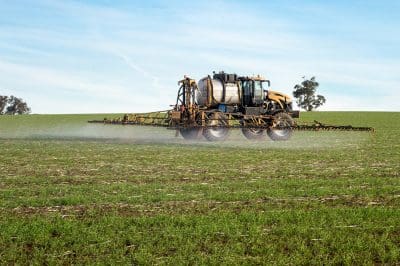NOZZLE type is an important consideration when growers are weighing up spray drift risks, but there are other critical factors, according to an internationally renowned expert in the field.

UQ researcher Dr Andrew Hewitt will be a guest presenter at the GRDC Grains Research Updates in Goondiwindi in March, where he will share the results of research investigating more than 1000 combinations of nozzle, pressure and tank mix in Australian crop spraying scenarios.
Dr Andrew Hewitt, a senior research fellow at the University of Queensland, Gatton, said years of research into spray drift management had prompted a reassessment of key influences.
He said while nozzle and droplet size were important factors, other considerations included managing wind direction and speed to reduce the risk of off-target impact, along with boom height and driving speed.
“Temperature inversion is also important, because it’s the other extreme where there’s little or no wind and it is a huge problem because there’s no dilution of the solution in the atmosphere,” Dr Hewitt said.
“Other critical considerations include nozzle, tank mix, and spray pressure, because they are all factors that impact droplet size.
“Growers and spray operators also need to be careful with adjuvants, because some could inadvertently increase other drift pathways such as vapour drift if they turn low volatile formulations into high volatile ones.
“However, many adjuvants are important in improving spray performance and when wisely chosen and paired with good nozzles and application conditions, they can be critical tools in the spray optimisation toolbox.”
Dr Hewitt leads a team of researchers supported by the GRDC that has measured the performance of more than 1000 combinations of nozzle, pressure and tank mix in Australian grain crop spraying scenarios.
The team has compiled more than 10 years of research and data into the new Australian Spray Performance Calculator.
The calculator is available as an Excel spreadsheet for growers to analyse the spray drift risk based on their individual on-farm conditions and variables. Work is also underway to take the tool to a digital platform as a smartphone app.
“We recognise that spray drift is an ongoing issue, not just here in Australia, but around the world,” Dr Hewitt said.
“Our driving force in developing the calculator is to give growers specific answers relating to their particular set-up. The calculator does all the complicated analysis about spray drift and coverage efficacy. It is Australian work tailored for Australian conditions.”
Growers wanting to know more about managing spray drift risks and using the spray performance calculator are encouraged to attend Dr Hewitt’s presentation on day one of the two-day GRDC Update at Goondiwindi, southern Queensland, on March 7-8.
Other topics on the agenda at the annual updates include: chickpea disease management; boom set ups for different spray jobs; optimizing yield in cereal crops after time of sowing, nutrition and variety trials across Queensland and NSW; the latest soil water and stubble management research and new insights into canola agronomy.
Visit: https://grdc.com.au/Media-Centre/Events/2017/03/Goondiwindi-GRDC-Grains-Research-Update



HAVE YOUR SAY